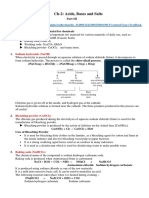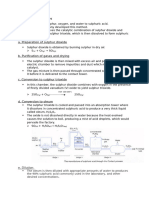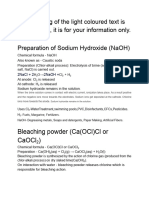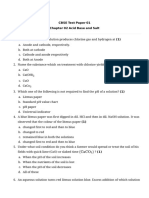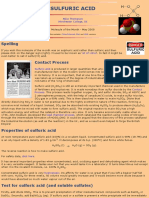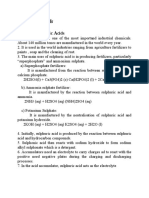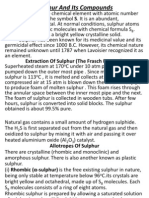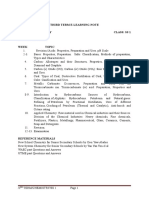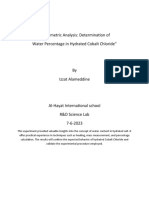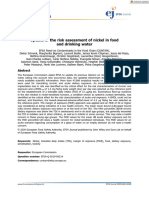Salts PDF
Salts PDF
Uploaded by
piyushCopyright:
Available Formats
Salts PDF
Salts PDF
Uploaded by
piyushOriginal Title
Copyright
Available Formats
Share this document
Did you find this document useful?
Is this content inappropriate?
Copyright:
Available Formats
Salts PDF
Salts PDF
Uploaded by
piyushCopyright:
Available Formats
SALTS
Salts are the ionic compounds which are produced after the neutralization
reaction between acid and base.
Family of Salt ---- Salts having common acidic or basic radicals are said to belong
to same family. Example:
Sodium chloride (NaCl) and Calcium chloride (CaCl2) belong to chloride family.
Sodium sulphate (Na2SO4), Potassium sulphate (K2SO4) and Aluminium sulphate
(Al2(SO4)3) belong to sulphate family.
Calcium chloride (CaCl2) and calcium sulphate (CaSO4) belong to calcium family.
Zinc chloride (ZnCl2) and Zinc sulphate (ZnSO4) belong to zinc family.
pH of Salts – Neutral salts, Acidic salts, Basic salts
Characteristics of salt:
i.Most of the salts are crystalline solid.
ii.Salts may be transparent or opaque.
iii.Most of the salts are soluble in water.
iv.Solution of salts conducts electricity.
v.Salts conduct electricity in their molten state also.
vi.The salt may be salty, sour, sweet, bitter and savory.
vii.Neutral salts are odourless.
viii.Salts can be colourless or of coloured.
Common Salt (Sodium Chloride) -
Sodium chloride (NaCl) is also known as common salt or table salt. It is formed
after the reaction between sodium hydroxide and hydrochloric acid.
NaOH + HCl --------- NaCl + H2O
i.It is a neutral salt.
ii.The pH value of sodium chloride is about 7.
iii.Sodium chloride is used in cooking as well as to prepare many other important
chemicals such as chemicals used in manufacturing industries.
iv.Electrol powder is an important substitute of common salt.
Common salt is an important starting material for the production of a number of
other chemicals such as
Sodium hydroxide (caustic soda).
Calcium oxychloride (bleaching powder).
Sodium HydrogenCarbonate(baking soda)
Sodium Decacarbonate (washing soda)
Sodium hydroxide NaOH (caustic soda)
When electricity is passed through an aqueous solution of sodium chloride (called
brine), it decomposes to form sodium hydroxide. The process is called the chlor-
alkali process because of the products formed– chlor for chlorine and alkali for
sodium hydroxide.
2NaCl(aq) + 2H2O(l) → 2NaOH(aq) + Cl2(g) + H2(g)
Chlorine gas is given off at the anode, and hydrogen gas at the cathode. Sodium
hydroxide solution is formed near the cathode.
(i) 2Cl−→ CI2 (g) + 2e− (anode reaction)
(ii) 2H2O + 2e−→ H2 + OH− (cathode reaction)
CalciumOxychloride (CaOCl2) Bleaching powder
Bleaching powder is also known as chloride of lime. It is a solid and yellowish
white in colour. Bleaching powder can be easily identified by the strong smell of
chlorine.
Bleaching powder is produced by the action of chlorine on dry slaked lime
[Ca(OH)2] at 373K . Bleaching powder is represented as CaOCl2, though the actual
composition is quite complex.
Ca(OH)2 + Cl2 → CaOCl2 + H2O
Bleaching powder is used –
(i) for bleaching cotton and linen in the textile industry, for bleaching
wood pulp in paper factories and for bleaching washed clothes in laundry;
(ii) as an oxidising agent in many chemical industries; and
(iii) for disinfecting drinking water to make it free of germs.
Beaching powder is not a compound but a mixture of compounds:
CaOCl2 .4H2O, CaCI2 .Ca(OH)2 .H2 0
Sodium hydrogencarbonate (NaHCO3)Baking soda
The chemical name of the compound is sodium hydrogencarbonate (NaHCO3). It
is produced using sodium chloride as one of the raw materials.
NaCl + H2O + CO2 + NH3 ------------ NH4Cl + NaHCO3 ® [Solvay process]
(Ammonium chloride) (Sodium hydrogencarbonate)
Properties:
It is a white crystalline solid and alkaline in nature.
It is mild , non-corrosive base.
Action of heat -- When solid baking soda (or its solution) is heated, it
decomposes to give sodium carbonate with the evolution of CO2 gas.
2NaHCO3 -----heat --------- Na2CO3 + H2O +CO2
[Example of Thermal Decomposition]
Uses of sodium hydrogencarbonate (NaHCO3):
(i) For making baking powder, which is a mixture of baking soda and a mild edible
acid such as tartaric acid. When baking powder is heated or mixed in water, the
following reaction takes place –
NaHCO3 + H+ → CO2 + H2O + Sodium salt of acid
(From any acid)
Carbon dioxide produced during the reaction causes bread or cake to rise, making
them soft and spongy.
(ii) Sodium hydrogencarbonate is also an ingredient in antacids. Being alkaline, it
neutralises excess acid in the stomach and provides relief.
(iii) It is also used in soda-acid fire extinguishers.
Sodium carbonate decahydrate[Washing soda] Na2CO3.10H2O
Sodium carbonate can be obtained by heating baking soda. Recrystallisation of
sodium carbonate [soda ash] gives washing soda. It is also a basic salt.
Properties of Washing Soda:
(a) Colour and state: It is a transparent crystalline solid (when f reshly prepared)
containing 10 molecules of water of crystallisation.
(b) Action of air: On exposure to air, washing soda crystals lose 9 molecules of
water of crystallisation to form a monohydrate which is a white powder
(transparent crystals) (washing powder)
This process is called efflorescence
(C) Action of heat: On heating, washing soda loses all the molecule of water and
becomes anhydrous.
Uses of washing soda:
(i) Sodium carbonate (washing soda) is used in glass, soap and paper industries.
(ii) It is used in the manufacture of sodium compounds such as borax
(iii) Sodium carbonate can be used as a cleaning agent for domestic purposes.
(iv) It is used for removing permanent hardness of water.
ARE THE CRYSTALLINE SALTS REALLY DRY
Water of crystallization : Many salts contain water molecule and are known as
hydrated salts. The water molecules present in salt is known as water of
crystallization. Water of crystallization is not free water, so it does not wet the
salts. Thus the crystalline salts which seem to be dry , contain water of
crystallization.
The fixed number of water molecules present in one formula unit of salt is called
water of crystallization
For example; copper sulphate pentahydrate (CuSO4.5H2O), ferrous Sulphate
heptahydrate (FeSO4.7H2O), Plaster of Paris (CaSO4.1/2H2O) etc
Calcium sulphate hemihydrate / Plaster of Paris (POP)
On heating gypsum (CaSO4.2H2O) at 373 K, it loses water molecules and becomes
calcium sulphate hemihydrate or Plaster of Paris (CaSO4.1/2H2O)
Properties of plaster of Paris (POP):
(a) Colour and state: It is a white powder.
(b) Reaction with water: Setting of Plaster of Paris (or POP). When POP is mixed
with water and left for half an hour to one hour, it sets to a hard mass due to
rehydration of POP to gypsum.
(c) Effect of heat: When POP is heated at 473K, it forms anhydrous
calcium Sulphate (CaSO4) which is known as dead burnt plaster. It has no
setting property as it takes up water very slowly.
Uses of POP : For making toys, materials for decoration, for making surfaces
smooth, a cast for setting broken bones
Q. How can you get half a water molecule?
Ans. It is written in this form because two formula units of CaSO4 share one
molecule of water.
HW: Q13 page 35.
You might also like
- JT BakerDocument73 pagesJT BakerwardoyogussanNo ratings yet
- Cape Chemistry Unit 2 Practicals PDFDocument30 pagesCape Chemistry Unit 2 Practicals PDFDaniel Roopchand75% (4)
- SALTSDocument2 pagesSALTSRatheesh HrishikeshNo ratings yet
- Chemistry Project: Name: Azad Abdullahi Class: Ss3S Teacher: Mr. AdekunleDocument14 pagesChemistry Project: Name: Azad Abdullahi Class: Ss3S Teacher: Mr. Adekunleapi-383198550% (2)
- Acids, Bases and Salts Notes - Part 4Document7 pagesAcids, Bases and Salts Notes - Part 4Dhyan ShahNo ratings yet
- Acids Bases and SaltsDocument4 pagesAcids Bases and SaltsMandeep SinghNo ratings yet
- CH 2 Topic - Salts 2Document5 pagesCH 2 Topic - Salts 2siratNo ratings yet
- Chap 7 - Materaisl of Common UseDocument6 pagesChap 7 - Materaisl of Common UsenongyaikeisamcodesNo ratings yet
- Ch-2 Part-3Document4 pagesCh-2 Part-3Kartik BhardwajNo ratings yet
- Sulphuric Acid 3613517c 7b1e 42b4 Be9c E88be08ae32dDocument9 pagesSulphuric Acid 3613517c 7b1e 42b4 Be9c E88be08ae32dshaikhkhushnuma601No ratings yet
- 10 ChemistryDocument7 pages10 Chemistrybahul9896No ratings yet
- Acid Base and Salts'Document4 pagesAcid Base and Salts'zaidasadsiddiquiNo ratings yet
- 2SDocument8 pages2SPro[ML] YTNo ratings yet
- Chemicals From Common Salt 2Document24 pagesChemicals From Common Salt 2KhushiNo ratings yet
- S.3 Chemistry MR SsemugoomaDocument9 pagesS.3 Chemistry MR SsemugoomalionlioneenjohnsmithNo ratings yet
- 10th SCIENCE (English Medium) Must DoDocument63 pages10th SCIENCE (English Medium) Must Doanshu26stNo ratings yet
- scienceDocument2 pagessciencesaanvi061227No ratings yet
- Notes On Salts Ch-2 Acids - Bases and SaltsDocument6 pagesNotes On Salts Ch-2 Acids - Bases and Salts23e010078No ratings yet
- FY 1 Substances in Common UseDocument5 pagesFY 1 Substances in Common Usesathvikjune2111No ratings yet
- Salts-1Document7 pagesSalts-1The Good BoysNo ratings yet
- CLS FDN-19!20!10 Che Module-1 Level-1 Chapter-2Document5 pagesCLS FDN-19!20!10 Che Module-1 Level-1 Chapter-2Utkarshini SrivastavaNo ratings yet
- 10 SC Chem AcidBaseSaltDocument9 pages10 SC Chem AcidBaseSaltAnwarYousafzaiNo ratings yet
- Chemical CompoundsDocument17 pagesChemical CompoundsKalu ChouhanNo ratings yet
- 1928 ADocument5 pages1928 AMarvel and D.C. EducationNo ratings yet
- Chapter-2 Acids, Bases and Salts: PropertiesDocument2 pagesChapter-2 Acids, Bases and Salts: PropertiesAkASHNo ratings yet
- SALTS Acids BasesDocument11 pagesSALTS Acids Basesdemocraticgamer30No ratings yet
- UntitledDocument4 pagesUntitledAarush GuptaNo ratings yet
- Shortcut ch2Document5 pagesShortcut ch2vemayis701No ratings yet
- Chapter 7Document16 pagesChapter 7sanalaptop7No ratings yet
- 10th Acid Base and Salt Notes 2011Document5 pages10th Acid Base and Salt Notes 2011Ashraf Husain100% (4)
- CP-XVII (Soda Ash & Caustic Soda)Document12 pagesCP-XVII (Soda Ash & Caustic Soda)Usman AliNo ratings yet
- Chem Notes 2Document3 pagesChem Notes 2suhaanahmed777No ratings yet
- Science 2 WS-1Document6 pagesScience 2 WS-1revathidhanabalan105No ratings yet
- Acid, Bases and Salts - NotesDocument5 pagesAcid, Bases and Salts - NotespritiNo ratings yet
- CarbohydratesDocument15 pagesCarbohydratespeelenguyNo ratings yet
- Ans - CLASS 10 SCIENCE Work Sheet Acids Bases Salts BY NBDocument5 pagesAns - CLASS 10 SCIENCE Work Sheet Acids Bases Salts BY NBdyadav1706No ratings yet
- Study of Components Sulphuric AcidDocument4 pagesStudy of Components Sulphuric AcidKavya YadavNo ratings yet
- Washing Soda-1Document25 pagesWashing Soda-1Muhammad RamzanNo ratings yet
- Wiki Sodium HydroxideDocument15 pagesWiki Sodium HydroxidesaiNo ratings yet
- Making Salts:: Acids and Reactive MetalsDocument3 pagesMaking Salts:: Acids and Reactive MetalsNur DilshadNo ratings yet
- Sodium Hydroxide: 1 PropertiesDocument9 pagesSodium Hydroxide: 1 PropertiesApolloMPNo ratings yet
- Sülfürik AsitDocument5 pagesSülfürik Asitsamet şenNo ratings yet
- The Leblanc and Solvay ProcessDocument4 pagesThe Leblanc and Solvay ProcessScribdTranslationsNo ratings yet
- Chemistry 3rd Term Note Wk8-9Document8 pagesChemistry 3rd Term Note Wk8-9shinekamsiogbodoNo ratings yet
- Solvay Process of Soda Ash ManufactureDocument16 pagesSolvay Process of Soda Ash ManufactureChristine FernandezNo ratings yet
- Chemistry Sulphuric Acid SolutionsDocument7 pagesChemistry Sulphuric Acid SolutionsGurjapsingh SandhuNo ratings yet
- Science SP Solutions - Chapter 2Document6 pagesScience SP Solutions - Chapter 2Filip JainNo ratings yet
- Alkaline Earth MetalDocument24 pagesAlkaline Earth Metalaayush basnetNo ratings yet
- Screenshot 2022-11-28 at 3.28.38 PMDocument4 pagesScreenshot 2022-11-28 at 3.28.38 PMAanya AroraNo ratings yet
- Chemistry Note 2Document11 pagesChemistry Note 2ebhojiayeemmanuel1No ratings yet
- Acids Bases and Salts WS1-3 AnswersDocument4 pagesAcids Bases and Salts WS1-3 Answersbhumika motiyaniNo ratings yet
- Oxyacids of SulphurDocument29 pagesOxyacids of SulphurSumaira Yasmeen100% (1)
- Sulphuric Acids: U O S ADocument10 pagesSulphuric Acids: U O S AMuhamad Dzul MuazzemNo ratings yet
- All Chemical Reactions 2023Document29 pagesAll Chemical Reactions 2023Aryan MishraNo ratings yet
- Salt Analysis (XII)Document18 pagesSalt Analysis (XII)Raju SinghNo ratings yet
- 10 Science Exemplar Chapter 2 AnswerDocument4 pages10 Science Exemplar Chapter 2 AnswersanyamNo ratings yet
- ABS - Important ChemicalsDocument20 pagesABS - Important ChemicalsAnoushka NathNo ratings yet
- Sulphur and Its CompoundsDocument24 pagesSulphur and Its CompoundsNwabueze Wazir Onuorah85% (13)
- Acids Bases and SaltsDocument52 pagesAcids Bases and SaltsPrabakaran MNo ratings yet
- Sodiumcarbonate 180826152936Document31 pagesSodiumcarbonate 180826152936Aliha AzmatNo ratings yet
- Preparation of PotassiumSulphateDocument5 pagesPreparation of PotassiumSulphatenithansaNo ratings yet
- Bashing The Geo AMC and AIMEDocument15 pagesBashing The Geo AMC and AIMEpiyushNo ratings yet
- Pss 3Document14 pagesPss 3piyushNo ratings yet
- Iitt Mess MenuDocument1 pageIitt Mess MenupiyushNo ratings yet
- Wilson TheoremDocument3 pagesWilson TheorempiyushNo ratings yet
- Rmo 2018 5Document2 pagesRmo 2018 5piyushNo ratings yet
- Piyush Jha Isi Cmi SolutionsDocument18 pagesPiyush Jha Isi Cmi SolutionspiyushNo ratings yet
- UntitledDocument10 pagesUntitledpiyushNo ratings yet
- Diophantine Equations (Ioqm/Prmo) Linear Combinations: Sum of Fourth PowersDocument5 pagesDiophantine Equations (Ioqm/Prmo) Linear Combinations: Sum of Fourth PowerspiyushNo ratings yet
- LOGARITHMSDocument10 pagesLOGARITHMSpiyushNo ratings yet
- Piyush Kumar Jha (Review ISI CMI) - Camellia (Wuh-Ssqx-Uaf - Mar 6, 2023)Document9 pagesPiyush Kumar Jha (Review ISI CMI) - Camellia (Wuh-Ssqx-Uaf - Mar 6, 2023)piyushNo ratings yet
- Worksheet 8 MCQDocument7 pagesWorksheet 8 MCQpiyushNo ratings yet
- CMO Sample Papers For Class 10Document5 pagesCMO Sample Papers For Class 10piyushNo ratings yet
- Putnam Problem Solving Seminar Week 5: Sums and Series: Alok AggarwalDocument4 pagesPutnam Problem Solving Seminar Week 5: Sums and Series: Alok AggarwalpiyushNo ratings yet
- Aakash National Talent Hunt Exam 2019: AnswersDocument1 pageAakash National Talent Hunt Exam 2019: AnswerspiyushNo ratings yet
- Circles AssignmentDocument2 pagesCircles AssignmentpiyushNo ratings yet
- Sikkim Mathematics ProjectDocument12 pagesSikkim Mathematics Projectpiyush83% (6)
- Pride L-1 WorkssheetDocument10 pagesPride L-1 WorkssheetpiyushNo ratings yet
- Maths: National InteractiveDocument4 pagesMaths: National InteractivepiyushNo ratings yet
- SCIENCE HOLIDAY HOMEWORK - Docx Class10Document4 pagesSCIENCE HOLIDAY HOMEWORK - Docx Class10piyushNo ratings yet
- Nimo 9Document10 pagesNimo 9piyushNo ratings yet
- Day 1Document2 pagesDay 1piyushNo ratings yet
- Form 3 The Mole Formulae and Chemical Equestionsuations Questions Teacher - Co .KeDocument5 pagesForm 3 The Mole Formulae and Chemical Equestionsuations Questions Teacher - Co .Kewanjirunjoroge379No ratings yet
- 3RD Term S1 ChemistryDocument44 pages3RD Term S1 ChemistryRikon UchihaNo ratings yet
- O Level Chemistry Revision Guide by Shahzad ZiaDocument30 pagesO Level Chemistry Revision Guide by Shahzad ZiaShahzad Zia80% (5)
- Water: 9 Chemistry (Unit 3)Document30 pagesWater: 9 Chemistry (Unit 3)SK GADDAMNo ratings yet
- Marcus 2018Document41 pagesMarcus 2018Bruno PereiraNo ratings yet
- Lab #1 Epsom SaltDocument5 pagesLab #1 Epsom SaltZinaida LopezNo ratings yet
- Libro de FosfatosDocument34 pagesLibro de Fosfatosaramis21trisha23No ratings yet
- Mole Calculations Unit TestDocument8 pagesMole Calculations Unit Testapi-340717257No ratings yet
- Exam 2Document11 pagesExam 2honkytonkzNo ratings yet
- Patente TSP Us 2Document5 pagesPatente TSP Us 2JanainaNo ratings yet
- Chemical 2012Document5 pagesChemical 2012Bagus BaskoroNo ratings yet
- Gravimetric Analysis Detemination of Water Percentage Content in Cobalt ChlorideDocument6 pagesGravimetric Analysis Detemination of Water Percentage Content in Cobalt ChlorideEn3am KhodareNo ratings yet
- J Efsa 2020 6268Document101 pagesJ Efsa 2020 6268Linda Setya WatiNo ratings yet
- Chapter 13 Acid Base TitrationsDocument6 pagesChapter 13 Acid Base Titrationsmukeshsriwastva14No ratings yet
- Cbjesccq 02Document12 pagesCbjesccq 02Sagar MittalNo ratings yet
- GYPSUM PRODUCTS AND THEIR Significance IN PROSTHETICSDocument50 pagesGYPSUM PRODUCTS AND THEIR Significance IN PROSTHETICSTavleen KaurNo ratings yet
- 17 Ch08 SolutionsDocument31 pages17 Ch08 SolutionsMoses AquinoNo ratings yet
- Ial WCH06 01 Nov19 PDFDocument16 pagesIal WCH06 01 Nov19 PDFsammam mahdi samiNo ratings yet
- Exp 4 - Hydrated Salt FormulaDocument7 pagesExp 4 - Hydrated Salt FormulaSiti FatimahNo ratings yet
- CNBP 024578Document8 pagesCNBP 024578Supriyanto Bin PraptoutomoNo ratings yet
- The Period 4 Transition MetalsDocument33 pagesThe Period 4 Transition MetalsprabhuNo ratings yet
- Experiment 02 The Determination of A Chemical FormulaDocument7 pagesExperiment 02 The Determination of A Chemical FormulaAlexya Rosas0% (1)
- Acids, Bases and SaltsDocument20 pagesAcids, Bases and SaltsTunde DabiriNo ratings yet
- Science Practical ManualDocument22 pagesScience Practical Manualdharani100% (1)
- Experiment 4.1Document5 pagesExperiment 4.1Shinehah YaonaNo ratings yet
- Determine Formula of Hydrate PDFDocument13 pagesDetermine Formula of Hydrate PDFesn_kNo ratings yet
- 2021 - The Effect of Precursor Concentration On The Particle SizeDocument14 pages2021 - The Effect of Precursor Concentration On The Particle SizeMoayad FlaifelNo ratings yet
- Production of Calcium Oxalate Monohydrate, Dihydrate or TrihydrateDocument4 pagesProduction of Calcium Oxalate Monohydrate, Dihydrate or Trihydrateguadie workuNo ratings yet








